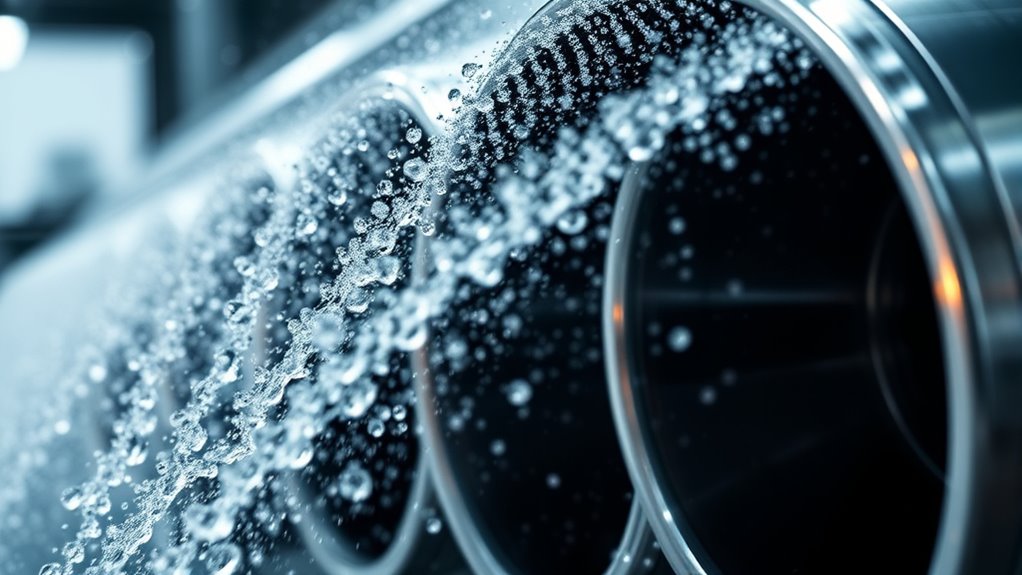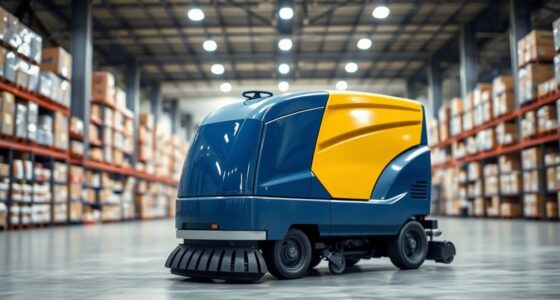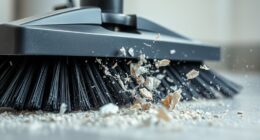Cylindrical scrubbers clean faster because their shape uses fluid dynamics to your advantage. The curved surface creates turbulence, increasing contact between the cleaning agent and grime while boosting scrubbing power. This design also maximizes contact area, covering surfaces more efficiently and reducing cleaning time. The physics behind this shape helps you do less manual effort for better results. Keep exploring to discover how these principles make cleaning even more effective and faster.
Key Takeaways
- The cylindrical shape creates turbulence that enhances contact between cleaning agents and surfaces, boosting cleaning efficiency.
- Curved surfaces naturally conform to irregular shapes, ensuring consistent contact and thorough cleaning.
- Fluid flow over cylinders generates swirling currents that increase scrubbing power without extra effort.
- Larger surface area exposed by cylinders allows more effective grime removal in less time.
- Physics principles like turbulence and surface contact optimize cleaning action, reducing manual effort and speeding up the process.

Cylindrical scrubbers often clean surfaces faster than traditional designs because of the unique physics at play. When you use a cylindrical shape, you tap into the principles of fluid dynamics and surface area in a way that maximizes cleaning efficiency. As you move the scrubber across a surface, the curved surface interacts with the cleaning medium—whether it’s water, cleaning solution, or air—creating a more dynamic flow. This flow enhances the agitation of dirt and grime, breaking them away more effectively than flat or irregular shapes.
The key lies in how fluid moves around a cylinder. Unlike flat scrubbers, cylindrical ones generate turbulence as fluid flows over their curved surface. This turbulence isn’t just a random effect; it actively increases contact between the cleaning agent and the surface. The curved shape causes the fluid to accelerate and swirl, which results in a more vigorous scrubbing action. Because of this, you don’t need to rely solely on brute force or prolonged scrubbing; the physics work to do much of the heavy lifting for you.
Cylindrical scrubbers create turbulence, increasing contact and scrubbing power through fluid acceleration and swirling.
Another vital aspect is surface area. Cylindrical scrubbers typically have a larger surface area exposed to the surface being cleaned compared to flat designs of similar size. This increased contact area means more of the cleaning solution or force is directly applied to the grime, making the cleaning process quicker and more thorough. When you’re using a cylindrical scrubber, you’ll notice it covers more ground in less time, thanks to the way its shape maximizes the area that interacts with dirt.
Furthermore, the shape allows for better handling of uneven surfaces. The curved surface can conform more naturally to irregular contours, maintaining consistent contact and ensuring no spot is left untouched. This means you spend less time going over the same area repeatedly, and dirt is removed more efficiently.
In addition, understanding the surface contact principles helps explain why cylindrical scrubbers are so effective—they optimize the interaction between the cleaning medium and the surface. The shape not only improves efficiency but also reduces the effort needed to achieve a thorough clean. In short, the physics behind cylindrical scrubbers—namely fluid dynamics and surface area—are what give them a significant advantage. They harness turbulence and maximize contact to clean faster and more effectively. When you understand the science, it’s clear why these tools outperform traditional flat or angular designs. You get a more efficient, thorough clean with less effort, simply because the shape works with the physics to do much of the work for you.
Frequently Asked Questions
How Do Cylindrical Scrubbers Differ From Traditional Cleaning Tools?
You’ll notice that cylindrical scrubbers differ from traditional tools by leveraging surface tension and fluid dynamics to improve cleaning. Their shape creates better contact with surfaces, directing water and cleaning agents more efficiently. This design enhances fluid flow, reducing cleaning time. By optimizing how liquids move and interact with surfaces, cylindrical scrubbers deliver faster, more effective results compared to conventional cleaning tools.
What Materials Are Most Effective for Manufacturing These Scrubbers?
You want effective cylindrical scrubbers, so focus on materials with high durability, such as stainless steel or reinforced plastics. These materials resist wear, corrosion, and damage, ensuring longevity. While they might have higher manufacturing costs upfront, their durability reduces replacement and maintenance expenses over time. Choosing the right material balances initial investment with long-term efficiency, making your scrubbers both resilient and cost-effective, ultimately delivering faster, more reliable cleaning performance.
Can Cylindrical Scrubbers Be Used for Industrial or Household Cleaning?
You can definitely use cylindrical scrubbers for both industrial and household cleaning. Their ergonomic design helps you clean more comfortably, while their chemical resistance guarantees durability against harsh cleaners. Whether you’re tackling tough grime in a factory or everyday mess at home, these scrubbers are versatile and effective. Their shape and material make them easy to handle, improve cleaning efficiency, and withstand exposure to various chemicals.
How Does the Size of a Scrubber Affect Its Cleaning Efficiency?
Think of a scrubber as a sponge catching every drop of dirt. When you increase its size, you boost its surface area, allowing more fluid dynamics to work with it. Larger scrubbers generally clean more efficiently because they cover more surface and interact with contaminants better. However, bigger isn’t always better—balance size with maneuverability for ideal cleaning. So, size impacts efficiency by enhancing surface area and fluid dynamics.
Are There Environmental Benefits to Using Cylindrical Scrubbers?
Using cylindrical scrubbers offers environmental benefits since they often utilize biodegradable materials, reducing landfill waste. Additionally, their design can lower energy consumption by cleaning more efficiently and quickly, saving power and resources. You’ll help decrease your carbon footprint by choosing these scrubbers, which are eco-friendly options that support sustainable practices. Overall, switching to cylindrical scrubbers benefits the environment while maintaining effective cleaning performance.
Conclusion
Just like the myth of Pygmalion transforming stone into life, understanding the physics behind cylindrical scrubbers reveals how they harness forces to clean faster. By leveraging turbulence and surface contact, you can see these devices as modern alchemists turning grime into clarity. So, next time you reach for a scrubber, remember it’s not just about scrubbing—it’s about channeling unseen forces to achieve a cleaner, brighter result with elegance and efficiency.









